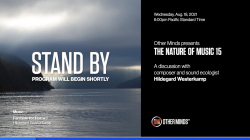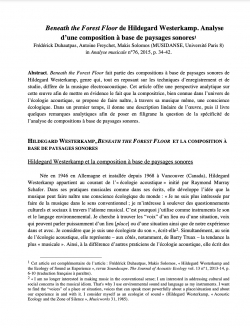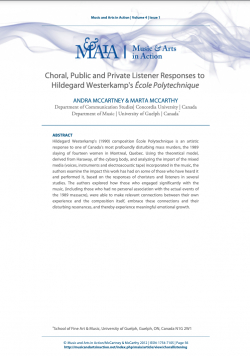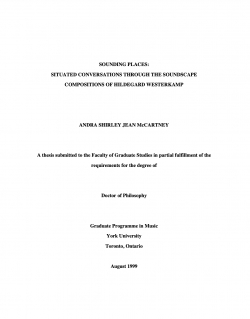Hildegard Westerkamp et l’écologie du son comme expérience
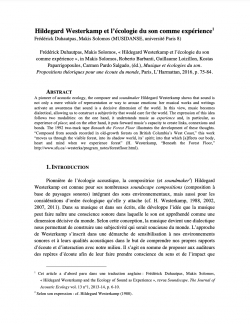
Book Stores
Type
Book
Category
Book Chapter
[ Browse Items ]
Publication Year
2016
Publisher
L'Harmattan, France
URL
[ private ]
Pages
75-84
Abstract
In Makis Solomos, Roberto Barbanti, Guillaume Loizillon, Kostas Paparrigopoulos, Carmen Pardo Salgado, (éd.), 'Musique et écologies du son. Propositions théoriques pour une écoute du monde', Paris, L'Harmattan 2016.
A pioneer of acoustic ecology, the composer and soundmaker Hildegard Westerkamp shows that sound is
not only a mere vehicle of representation or way to arouse emotions: her musical works and writings
activate an awareness that sound is a decisive dimension of the world. In this view, music becomes
dialectical, allowing us to construct a subjectivity that would care for the world. The expression of this idea
follows two modalities: on the one hand, it understands music as experience and, in particular, as
experience of place; and on the other hand, it puts forward music’s capacity to create links, connexions and
bonds. The 1992 two-track tape Beneath the Forest Floor illustrates the development of these thoughts.
“Composed from sounds recorded in old-growth forests on British Columbia’s West Coast,” this work
“moves us through the visible forest, into its shadow world, its’ spirit; into that which [a]ffects our body,
heart and mind when we experience forest” (H. Westerkamp, “Beneath the Forest Floor,”
http://www.sfu.ca/~westerka/program_notes/forestfloor.html).
A pioneer of acoustic ecology, the composer and soundmaker Hildegard Westerkamp shows that sound is
not only a mere vehicle of representation or way to arouse emotions: her musical works and writings
activate an awareness that sound is a decisive dimension of the world. In this view, music becomes
dialectical, allowing us to construct a subjectivity that would care for the world. The expression of this idea
follows two modalities: on the one hand, it understands music as experience and, in particular, as
experience of place; and on the other hand, it puts forward music’s capacity to create links, connexions and
bonds. The 1992 two-track tape Beneath the Forest Floor illustrates the development of these thoughts.
“Composed from sounds recorded in old-growth forests on British Columbia’s West Coast,” this work
“moves us through the visible forest, into its shadow world, its’ spirit; into that which [a]ffects our body,
heart and mind when we experience forest” (H. Westerkamp, “Beneath the Forest Floor,”
http://www.sfu.ca/~westerka/program_notes/forestfloor.html).
Description
https://hildegardwesterkamp.ca/resources/PDFs/writings-pdf/hildegard_westerkamp_et_lecologie_du_son_comme_experience.pdf
Number of Copies
1
| Library | Accession No | Call No | Copy No | Edition | Location | Availability |
|---|---|---|---|---|---|---|
| Main | 343 | 1 | Yes |
